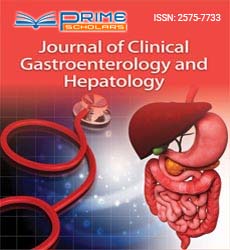Commentry - (2021) Volume 5, Issue 4
Hepatocellular Adenoma and its Pathologic Features
Liang Manuel*
Department of Endocrinology, Hebei Medical University, Shijiazhuang, China
*Correspondence:
Liang Manuel, Department of Endocrinology, Hebei Medical University, Shijiazhuang,
China,
Email:
Received: 10-Dec-2021
Published:
31-Dec-2021
Description
Hepatocellular Adenoma (HCA) also called hepatic adenoma is an abnormal solid benign liver lesion that develops in the liver that looks normal. HCA usually occurs alone and is found in young women in connection with the use of estrogen-containing drugs. In addition, patients with glycogen storage disease or metabolic syndrome are at increased risk of developing HCA. HCA can be classified based on genotype and phenotypic characteristics. All subtypes show enhancement of the arterial phase on Magnetic Resonance Imaging (MRI), but subsequent phase enhancement patterns depend on the lesion subtype. If MRI cannot identify the subtype, a biopsy may help to identify the subtype from histology. However, lesion biopsy is not commonly performed in clinical practice for this purpose.
The HCA subtypes are:
HCA with hepatocyte nuclear factor (HNF)-1 alpha mutation
HNF1-alpha mutation-positive HCA occurs almost exclusively in females, accounts for 35-50% of HCA, and is characterized by diffuse steatosis and the absence of cytological abnormalities or inflammatory infiltration. On MRI, HNF1-alpha mutation-positive HCA shows moderate arterial enhancement that does not extend to the portal phase. This subtype is associated with a low risk of complications for lesions smaller than 5 cm.
Inflammatory HCA
Inflammatory HCA occurs primarily in females and accounts for 40-55% of HCA. The histological appearance is characterized by inflammatory infiltration, sinusoidal dilation, winding blood vessels, and bleeding. MRI shows severe arterial enlargement that persists into the portal vein and delayed phase.
HCA with beta-catenin activation
Beta-catenin-activated HCA is less common than other subtypes (10-15% of patients) and is more common in men.
They are associated with the use of androgens and do not show specific features on contrast-enhanced polymorphic MRI. Morphologically, the beta-catenin subtype is characterized by cell atypia, cholestasis, and pseudoglandular formation.
HCA with beta-catenin mutations is associated with an increased risk of malignant transformation. In a series of 96 patients with HCA, HCA associated with hepatocellular carcinoma (or exhibiting histological features adjacent to hepatocellular carcinoma) was observed almost exclusively in the beta-catenin group.
Pathologic Features
HCA is usually a single, well-bounded lesion that ranges in size from a few millimetres to a few centimetres. HCA in stalk-like form is rarely seen. Lesions are often located in the right lobe of the liver and are soft and smooth with a brown appearance. Liver sinusoids are sourced from a prominent arterial system, and the absence of a fibrous cap contributes to lesion rupture and the development of intra-abdominal hemorrhage, resulting in complications such as hemorrhage and necrosis.
Microscopically, HCA is composed of a large sheet of adenomatous cells, usually larger than normal hepatocytes, containing glycogen and lipids. The nuclei are small and regular, with few mitosis. Adenomatous cells are located in normal or thickened trabecular dotted with prominent arteries and thin- walled blood vessels and vas sinusoids. A small number of Kupffer cells may also be present. There is a significant lack of normal liver structure (i.e., portal tract, bile duct), and this function helps distinguish HCA from focal nodular hyperplasia. The exception is inflammatory HCA because it contains vascular structures.
Citation: Manuel L (2021) Hepatocellular Adenoma and its Pathologic Features. J Clin Gastroenterol Hepatol Vol.5 No.4:3.
Copyright: This is an open access article distributed under the terms of the Creative Commons Attribution License, which permits unrestricted use, distribution, and reproduction in any medium, provided the original work is properly cited.

